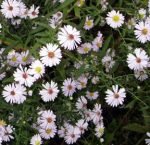 Heath aster is a herbaceous perennial native to central and eastern US where it grows in open areas including roadways and railroads. It is a member of the Asteraceae family that also includes daisies, sunflowers, and lettuce. The compact bushy plants spread by rhizomes and form loose colonies but can become invasive in the right conditions. The much-branched stems carry stiff, lance-shaped, sessile leaves that are one to three inch long. The leaves resemble those of heather (Erica) giving rise to the common name and specific epithet (ericoides). A multitude of daisy-like flowerheads ½ inch across appear in late summer to fall on stiff terminal and side branches often in one-sided racemes. Each flowerhead is composed of central yellow disc flowers surrounded by ray flowers that are white, sometimes light blue or pink. Plants may need staking but are mildew resistant and need little care. Flowers attract butterflies and native bees, are are good cut flowers. Seeds attract birds. Good choice for wildflower, native, or rock gardens. The generic name Aster is the Latin meaning star and refers to the shape of the flower. The generic name Symphyotrichum comes from the Greek symph meaning coming together and trich meaning hair and possible refers to the anthers.
Heath aster is a herbaceous perennial native to central and eastern US where it grows in open areas including roadways and railroads. It is a member of the Asteraceae family that also includes daisies, sunflowers, and lettuce. The compact bushy plants spread by rhizomes and form loose colonies but can become invasive in the right conditions. The much-branched stems carry stiff, lance-shaped, sessile leaves that are one to three inch long. The leaves resemble those of heather (Erica) giving rise to the common name and specific epithet (ericoides). A multitude of daisy-like flowerheads ½ inch across appear in late summer to fall on stiff terminal and side branches often in one-sided racemes. Each flowerhead is composed of central yellow disc flowers surrounded by ray flowers that are white, sometimes light blue or pink. Plants may need staking but are mildew resistant and need little care. Flowers attract butterflies and native bees, are are good cut flowers. Seeds attract birds. Good choice for wildflower, native, or rock gardens. The generic name Aster is the Latin meaning star and refers to the shape of the flower. The generic name Symphyotrichum comes from the Greek symph meaning coming together and trich meaning hair and possible refers to the anthers.
Type: Herbaceous perennial
Bloom: Daisy-like flowerheads with white often blue or pink ray flowers surrounding yellow disc flowers carried on terminal or side-branches often in one sided racemes from late summer into fall
Size: 1-3’ H x 1.5’ W
Light: Full sun
Soil: Average, dry to medium moist, well-drained; tolerant of drought and lean soil.
Hardiness: Zones 3-10
Care: May need staking
Pests and Diseases: Generally healthy; mildew resistant
Propagation: Seed, division
Companion Plants: Grasses especially needle grass, big bluestem, switch grass, showy sunflower, (Helianthus pauciflorus), prairie cinquefoil (Drymocallis arguta), stiff goldenrod (Solidago-rigida), rosinweed (Silphium integrifolium), compass plant (Silphium laciniatum), prairie dock (Silphium terebinthinaceum), purple prairie clover (Silphium terebinthinaceum)
Outstanding Selections:
‘Cinderella (yellow ray flowers with reddish disc flowers, 2.5’ tall)
‘Blue Star’ (blue flowerheads)